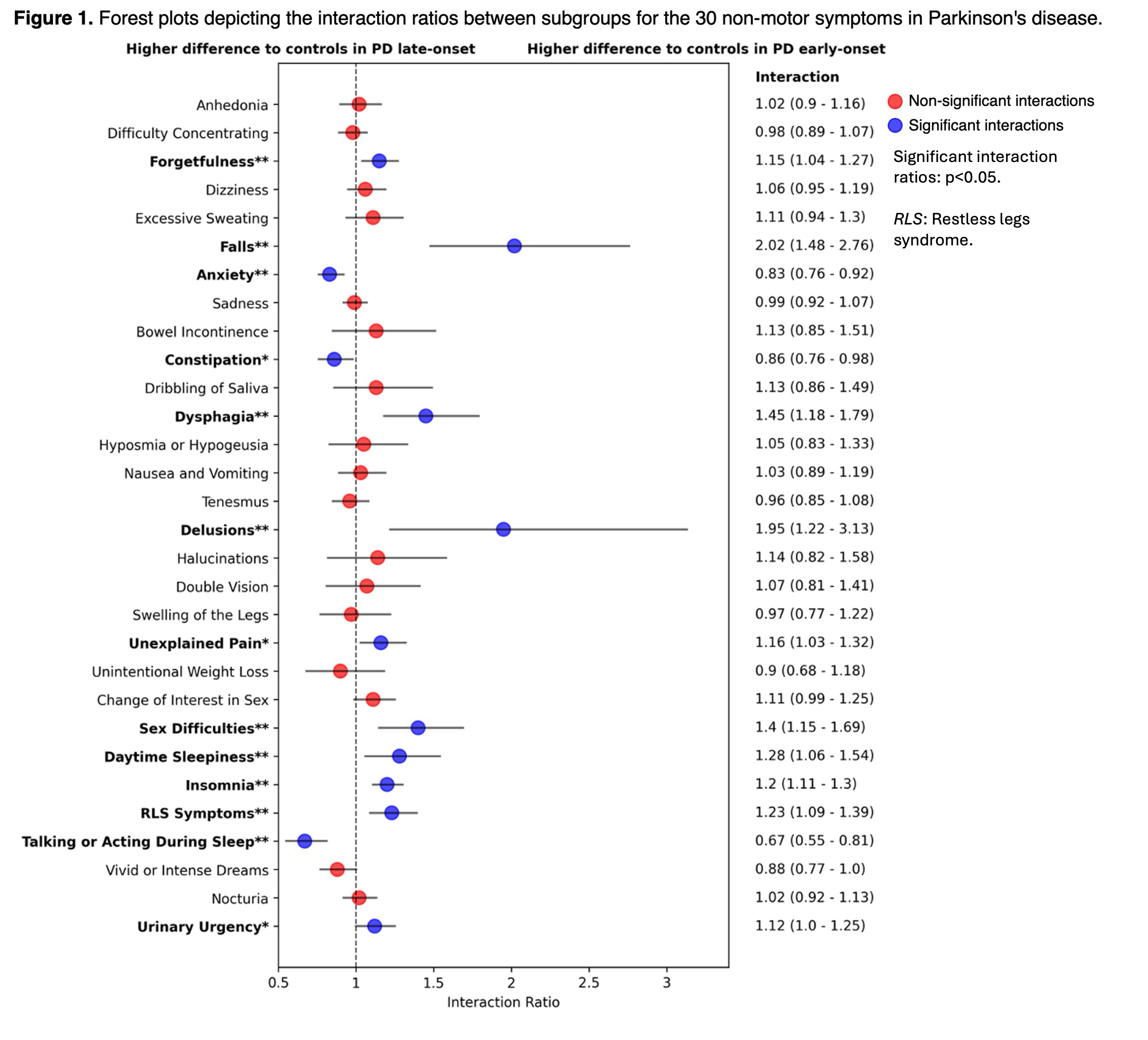Category: Parkinson's Disease: Non-Motor Symptoms
Objective: To compare late-onset and early-onset patients with Parkinson’s Disease (PD) in how they differ from their matched healthy controls (HC) regarding the presence of non-motor symptoms (NMS).
Background: PD is characterized by both motor and NMS. However, it is a heterogeneous disease and the distribution of NMS across different demographic groups still needs better understanding. Early-onset PD (EO-PD) and late-onset PD (LO-PD) present different clinical features regarding progression rate and symptom severity. Characterizing NMS between these two groups is essential for advancing PD care and tailoring interventions to meet diverse patient needs.
Method: We utilized early-stage (≤ 3 years since diagnosis) PD patients’ baseline data from the Fox Insight study [1]. They were divided into two control-matched groups: EO-PD (n = 2,064) and LO-PD (n = 13,560). The assessment of 30 NMS was conducted using the Nonmotor Symptom Questionnaire. A sensitivity analysis was conducted including only patients diagnosed with PD by a movement disorders specialist. All pairwise comparisons between EO-PD and LO-PD were performed through prevalence ratios of NMS in PD relative to HC. We applied an Analysis of Covariance between PD groups and employed robust Poisson regression models for categorical variables. Multiple comparisons were corrected through the Bonferroni method. A significance threshold was set with p < 0.00167.
Results: EO-PD exhibit proportionately more NMS in comparison to their matched than LO-PD exhibited in relation to theirs (adjusted mean difference [AMD] of 0.95 [95% CI: 0.45 – 1.45]). EO-PD to HC showed increased complains of cognitive functions (AMD = 0.17 [95% CI: 0.07 – 0.28]), cardiovascular conditions (AMD = 0.16 [95% CI: 0.09 – 0.24]), hallucinations (AMD = 0.06 [95% CI: 0.03 – 0.09]), sleep disturbances (AMD = 0.20 [95% CI: 0.08 – 0.32]), sexual dysfunction (AMD = 0.15 [95% CI: 0.08 – 0.22]), and other uncategorized symptoms (AMD = 0.12 [95% CI: 0.04 – 0.20]). Both groups presented similar responses in the sensibility analysis.
Conclusion: EO-PD seems to differ from HC with a higher magnitude than LP-PD to theirs, suggesting that NMS may have a greater diagnostic value for EO-PD. Additional research is required to determine whether it can guide personalized treatment and strategies aimed at enhancing the quality of life for these patients.
Figure 1
References: [1]. Smolensky L, Amondikar N, Crawford K, et al. Fox Insight collects online, longitudinal patient-reported outcomes and genetic data on Parkinson’s disease. Sci Data. 2020;7(1):67.
To cite this abstract in AMA style:
A. Oliveira Franco, D. Teixeira-Dos-Santos, A. Noyce, S. Bandres-Ciga, A. Schumacher Schuh. Age of Onset and Non-Motor Symptoms in Early Parkinson’s Disease: A Data-Analysis Study Based on the Fox Insight Cohort [abstract]. Mov Disord. 2024; 39 (suppl 1). https://www.mdsabstracts.org/abstract/age-of-onset-and-non-motor-symptoms-in-early-parkinsons-disease-a-data-analysis-study-based-on-the-fox-insight-cohort/. Accessed December 16, 2025.« Back to 2024 International Congress
MDS Abstracts - https://www.mdsabstracts.org/abstract/age-of-onset-and-non-motor-symptoms-in-early-parkinsons-disease-a-data-analysis-study-based-on-the-fox-insight-cohort/

